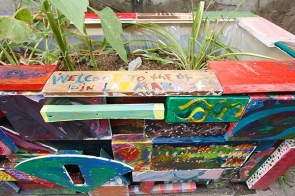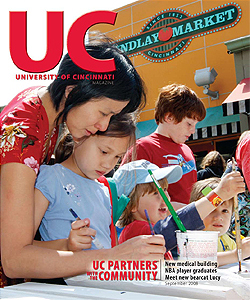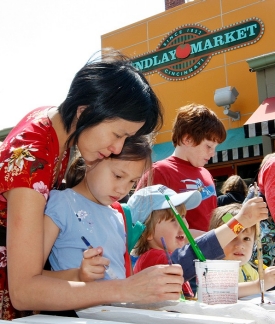Worth a thousand words
Fingerprints, brush strokes, more than 100 painted names. Every color of the rainbow is represented on the long, narrow wooden boards --scrap material discarded by someone else. At first, it doesn't look like a work of art.
And, in fact, it isn't just art. It's a bridge between communities.
The fingerprints and brush strokes are those of 15 Hughes High School students who worked with students in the College of Design, Architecture, Art, and Planning to create the piece of fine art for the DAAP building. The names represent all those who have participated in the Art in the Market program, which pairs youth from Cincinnati Public Schools with UC students and faculty to make public works of art that not only add aesthetic beauty to the city, but also bring two worlds together.
For the past decade, Art in the Market has been using murals, paintings and sculptures to enhance and embrace Cincinnati's Over-the-Rhine neighborhood, Findlay Market in particular. One of the program's past projects was in creating temporary murals on facades of empty buildings on Vine Street, a partnership with Keep Cincinnati Beautiful. Funding for projects comes from a variety of sources. The latest project was supported in part by a $4,000 donation from UC's Center for Community Engagement through a grant from Ohio Campus Compact. Outside partners, such as the non-profit Memorial, Inc., and the Ohio Arts Council, also provide funding and resources.
"The program really puts the university in a wonderful place to work with communities, not for them, to create works that are ultimately empowering," says Flavia Bastos, director of Art in the Market since 2003 and an associate professor of art education at UC.
In 2008, Art in the Market commemorates its 10th anniversary with two pieces, one located in Findlay Market and the other in DAAP. Since the program's inception under founder Frank Russell, now director of DAAP's Community Design Center, more than 100 local teens have helped create 40 to 50 works of art, both temporary and permanent pieces, displayed throughout the community.
The latest pieces of artwork are made entirely of recycled materials. In Findlay Market, the students asked visitors to add their own touches to the three-dimensional wood collage, which covers an existing trellis and includes birdhouses. The trellis is the entrance for an alley that connects the market to a park where locals congregate for baseball games and barbecues. Part of the idea behind the project, unveiled in June, is to make the alley friendlier for people to pass through, especially at night.
To create a sense of unity between the UC and Findlay Market works, local artist Deb Brod, MFA (DAAP) '92, the grand architect for both pieces, used the same types of materials. Bastos says the similarities are meant to create a connection between the two pieces, while also linking the local high school and UC students to each work of art.

Photo/Andrew Higley
"We want these young people to understand that it's totally possible for them to be part of a university community," Bastos says. "I think by being here and becoming familiar with a university environment, the likelihood of them considering college and future education increases."
The collaboration also has benefits for participants already in college. DAAP students begin work with the youth in the fall to create proposed plans for the project. Then in the spring, they bring their creation to life.
For Jennifer Rocklin, DAAP '07, her undergraduate Art in the Market experience wasn't enough. She signed up for a second tour as a graduate student. To her, Art in the Market offers a distinct opportunity to bring many people from different backgrounds together to work on a single project.
Bastos says her mostly middle-class DAAP students' exposure to different populations through Art in the Market is important to success in their fields. "It's an opportunity for my students to understand diversity and deal with it in a real way. It sensitizes them to diversity in people, and I think that's the only way we create anything, including artwork, that is accessible to a number of audiences," she says.
Looking forward, Bastos would like to see the program evolve to include more measurements of how the projects are helping high school participants pursue college careers. While much emphasis is placed on science and technology in education, Bastos says art holds a unique place in a curriculum.
"We are forgetting what's most precious to humanity, which is our ability to make meaning. These urban kids have a lot of interesting things to say, which need to be incorporated into higher education. When we have the kids on campus, we're already planting the idea that college is a viable option."
The seed has certainly been planted in Elijah Pennington, an 11th grader at Hughes High School, and his classmate, Nai'Zsa Wilfong, in the 10th grade. Both say they will remember learning how to paint and meeting "friendly people." Plus, they are planning to go to college, and UC comes up as a strong possibility.
Dominik Jackson, in the ninth grade, already knows he wants to attend college to study animation. Jackson shares his career plans quietly while holding a small can of paint, some of which has found its way on to his hands and arms, during an Art in the Market studio session.
"I think that's the real legacy of the Art in the Market program," Bastos says. "The history of all the youth who have been part of it embedded in these works around Findlay Market, in their own community."

 Issue Archive
Issue Archive